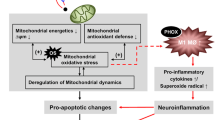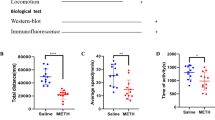Abstract
Identification of the mechanisms by which drugs of abuse cause neuronal dysfunction is essential for understanding the biological bases of their acute and long-lasting effects in the brain. Here, we performed real-time functional experiments of axonal transport of mitochondria to explore the role of in situ mitochondrial dysfunction in 3,4-methylenedioxymethamphetamine (MDMA; “ecstasy”)-related brain actions. We showed that MDMA dramatically reduced mitochondrial trafficking in hippocampal neurons in a Tau-dependent manner, in which glycogen synthase kinase 3β activity was implicated. Furthermore, we found that these trafficking abnormalities were rescued by over-expression of Mitofusin2 and dynamin-related protein 1, but not of Miro1. Given the relevance of mitochondrial targeting for neuronal function and neurotransmission, our data underscore a novel mechanism of action of MDMA that may contribute to our understanding of how this drug of abuse alters neuronal functioning.





Similar content being viewed by others
References
Alves E, Summavielle T, Alves CJ et al (2007) Monoamine oxidase-B mediates ecstasy-induced neurotoxic effects to adolescent rat brain mitochondria. J Neurosci 27:10203–10210
Alves E, Binienda Z, Carvalho F et al (2009a) Acetyl-l-carnitine provides effective in vivo neuroprotection over 3,4-methylenedioximethamphetamine-induced mitochondrial neurotoxicity in the adolescent rat brain. Neuroscience 158:514–523
Alves E, Summavielle T, Alves CJ et al (2009b) Ecstasy-induced oxidative stress to adolescent rat brain mitochondria in vivo: influence of monoamine oxidase type A. Addict Biol 14:185–193
Atkin TA, MacAskill AF, Brandon NJ, Kittler JT (2013) Disrupted in schizophrenia-1 regulates intracellular trafficking of mitochondria in neurons. Mol Psychiatry 16:122–124
Bai F, Jones DC, Lau SS, Monks TJ (2001) Serotonergic neurotoxicity of 3,4-(±)-methylenedioxyamphetamine and 3,4-(±)-methylendioxymethamphetamine (ecstasy) is potentiated by inhibition of γ-glutamyl transpeptidase. Chem Res Toxicol 14:863–870
Barbosa DJ, Capela JP, Oliveira JMA et al (2012) Pro-oxidant effects of Ecstasy and its metabolites in mouse brain synaptosomes. Br J Pharmacol 165:1017–1033
Barbosa DJ, Capela JP, Silva R et al (2014a) “Ecstasy”-induced toxicity in SH-SY5Y differentiated cells: role of hyperthermia and metabolites. Arch Toxicol 88:515–531
Barbosa DJ, Capela JP, Silva R et al (2014b) The mixture of “ecstasy” and its metabolites is toxic to human SH-SY5Y differentiated cells at in vivo relevant concentrations. Arch Toxicol 88:455–473
Busceti CL, Biagioni F, Riozzi B et al (2008) Enhanced tau phosphorylation in the hippocampus of mice treated with 3,4-methylenedioxymethamphetamine (“ecstasy”). J Neurosci 28:3234–3245
Byun J, Kim BT, Kim YT, Jiao Z, Hur E, Zhou F (2012) Slit2 inactivates GSK3β to signal neurite outgrowth inhibition. PLoS One 7:e51895
Capela JP, Ruscher K, Lautenschlager M et al (2006) Ecstasy-induced cell death in cortical neuronal cultures is serotonin 2A-receptor-dependent and potentiated under hyperthermia. Neuroscience 139:1069–1081
Capela JP, Macedo C, Branco PS et al (2007) Neurotoxicity mechanisms of thioether ecstasy metabolites. Neuroscience 146:1743–1757
Capela JP, Carmo H, Remião F, Bastos ML, Meisel A, Carvalho F (2009) Molecular and cellular mechanisms of ecstasy-induced neurotoxicity: an overview. Mol Neurobiol 39:210–271
Capela JP, da Costa Araújo S, Costa VM et al (2013) The neurotoxicity of hallucinogenic amphetamines in primary cultures of hippocampal neurons. Neurotoxicology 34:254–263
Carvalho M, Remiao F, Milhazes N et al (2004) The toxicity of N-methyl-alpha-methyldopamine to freshly isolated rat hepatocytes is prevented by ascorbic acid and N-acetylcysteine. Toxicology 200:193–203
Cereghetti GM, Stangherlin A, de Brito OM et al (2008) Dephosphorylation by calcineurin regulates translocation of Drp1 to mitochondria. Proc Natl Acad Sci USA 105:15803–15808
Creed MC, Lüscher C (2013) Drug-evoked synaptic plasticity: beyond metaplasticity. Curr Opin Neurobiol 23:553–558
Darvesh AS, Gudelsky GA (2005) Evidence for a role of energy dysregulation in the MDMA-induced depletion of brain 5-HT. Brain Res 1056:168–175
de Barreda EG, Pérez M, Ramos PG et al (2010) Tau-knockout mice show reduced GSK3-induced hippocampal degeneration and learning deficits. Neurobiol Dis 37:622–629
Deheshi S, Pasqualotto BA, Rintoul GL (2013) Mitochondrial trafficking in neuropsychiatric diseases. Neurobiol Dis 51:66–71
Detmer SA, Chan DC (2007) Complementation between mouse Mfn1 and Mfn2 protects mitochondrial fusion defects caused by CMT2A disease mutations. J Cell Biol 176:405–414
Feng J, Nestler EJ (2013) Epigenetic mechanisms of drug addiction. Curr Opin Neurobiol 23:521–528
Granado N, Ares-Santos S, Oliva I et al (2011) Dopamine D2-receptor knockout mice are protected against dopaminergic neurotoxicity induced by methamphetamine or MDMA. Neurobiol Dis 42:391–403
Itoh K, Nakamura K, Iijima M, Sesaki H (2013) Mitochondrial dynamics in neurodegeneration. Trends Cell Biol 23:64–71
Kageyama Y, Zhang Z, Roda R et al (2012) Mitochondrial division ensures the survival of postmitotic neurons by suppressing oxidative damage. J Cell Biol 197:535–551
Kenny PJ (2011) Common cellular and molecular mechanisms in obesity and drug addiction. Nat Rev Neurosci 12:638–651
Kopeikina KJ, Carlson GA, Pitstick R et al (2011) Tau accumulation causes mitochondrial distribution deficits in neurons in a mouse model of tauopathy and in human Alzheimer’s disease grain. Am J Pathol 179:2071–2082
Lee S, Sterky FH, Mourier A et al (2012) Mitofusin 2 is necessary for striatal axonal projections of midbrain dopamine neurons. Hum Mol Genet 21:4827–4835
Li Z, Okamoto K, Hayashi Y, Sheng M (2004) The importance of dendritic mitochondria in the morphogenesis and plasticity of spines and synapses. Cell 119:873–887
Llorens-Martín M, López-Doménech G, Soriano E, Avila J (2011) GSK3β is involved in the relief of mitochondria pausing in a tau-dependent manner. PLoS One 6:e27686
López-Doménech G, Serrat R, Mirra S et al (2012) The Eutherian Armcx genes regulate mitochondrial trafficking in neurons and interact with Miro and Trak2. Nat Commun 3:814
Lüscher C (2013) Cocaine-evoked synaptic plasticity of excitatory transmission in the ventral tegmental area. Cold Spring Harb Perspect Med 3:a012013
Lüscher C, Malenka RC (2011) Drug-evoked synaptic plasticity in addiction: from molecular changes to circuit remodeling. Neuron 69:650–663
MacAskill AF, Kittler JT (2010) Control of mitochondrial transport and localization in neurons. Trends Cell Biol 20:102–112
Macaskill AF, Rinholm JE, Twelvetrees AE et al (2009) Miro1 is a calcium sensor for glutamate receptor-dependent localization of mitochondria at synapses. Neuron 61:541–555
MacAskill AF, Atkin TA, Kittler JT (2010) Mitochondrial trafficking and the provision of energy and calcium buffering at excitatory synapses. Eur J Neurosci 32:231–240
Miller KE, Sheetz MP (2004) Axonal mitochondrial transport and potential are correlated. J Cell Sci 117:2791–2804
Misko A, Jiang S, Wegorzewska I, Milbrandt J, Baloh RH (2010) Mitofusin 2 is necessary for transport of axonal mitochondria and interacts with the Miro/Milton complex. J Neurosci 30:4232–4240
Misko AL, Sasaki Y, Tuck E, Milbrandt J, Baloh RH (2012) Mitofusin2 mutations disrupt axonal mitochondrial positioning and promote axon degeneration. J Neurosci 32:4145–4155
Morel M, Authelet M, Dedecker R, Brion JP (2010) Glycogen synthase kinase-3β and the p25 activator of cyclin dependent kinase 5 increase pausing of mitochondria in neurons. Neuroscience 167:1044–1056
Park H, Kam T, Kim Y et al (2012) Neuropathogenic role of adenylate kinase-1 in Aβ-mediated tau phosphorylation via AMPK and GSK3β. Hum Mol Genet 21:2725–2737
Pathak D, Sepp KJ, Hollenbeck PJ (2010) Evidence that myosin activity opposes microtubule-based axonal transport of mitochondria. J Neurosci 30:8984–8992
Perier C, Vila M (2012) Mitochondrial biology and Parkinson’s disease. Cold Spring Harb Perspect Med 2:a009332
Puerta E, Hervias I, Goñi-Allo B et al (2010) Methylenedioxymethamphetamine inhibits mitochondrial complex I activity in mice: a possible mechanism underlying neurotoxicity. Br J Pharmacol 160:233–245
Quinton MS, Yamamoto BK (2006) Causes and consequences of methamphetamine and MDMA toxicity. AAPS J 8:337–347
Ricaurte GA, Yuan J, McCann UD (2000) (±)3,4-Methylenedioxymethamphetamine (‘ecstasy’)-induced serotonin neurotoxicity: studies in animals. Neuropsychobiology 42:5–10
Rintoul GL, Reynolds IJ (2010) Mitochondrial trafficking and morphology in neuronal injury. Biochim Biophys Acta 1802:143–150
Saxton WM, Hollenbeck PJ (2012) The axonal transport of mitochondria. J Cell Sci 125:2095–2104
Shahpasand K, Uemura I, Saito T et al (2012) Regulation of mitochondrial transport and inter-microtubule spacing by tau phosphorylation at the sites hyperphosphorylated in Alzheimer’s disease. J Neurosci 32:2430–2441
Shao L, Martin MV, Watson SJ et al (2008) Mitochondrial involvement in psychiatric disorders. Ann Med 40:281–295
Sheng Z, Cai Q (2012) Mitochondrial transport in neurons: impact on synaptic homeostasis and neurodegeneration. Nat Rev Neurosci 13:77–93
Shutt TE, McBride HM (2013) Staying cool in difficult times: mitochondrial dynamics, quality control and the stress response. Biochim Biophys Acta 1833:417–424
Simantov R, Tauber M (1997) The abused drug MDMA (ecstasy) induces programmed death of human serotonergic cells. FASEB J 11:141–146
van Spronsen M, Mikhaylova M, Lipka J et al (2013) TRAK/Milton motor-adaptor proteins steer mitochondrial trafficking to axons and dendrites. Neuron 77:485–502
Verstreken P, Ly CV, Venken KJT, Koh T, Zhou Y, Bellen HJ (2005) Synaptic mitochondria are critical for mobilization of reserve pool vesicles at drosophila neuromuscular junctions. Neuron 47:365–378
Vossel KA, Zhang K, Brodbeck J et al (2010) Tau reduction prevents Aβ-induced defects in axonal transport. Science 330:198
Wang X, Schwarz TL (2009) The mechanism of Ca2+-dependent regulation of kinesin-mediated mitochondrial motility. Cell 136:163–174
Wang DB, Garden GA, Kinoshita C et al (2013) Declines in Drp1 and Parkin expression underlie DNA damage-induced changes in mitochondrial length and neuronal death. J Neurosci 33:1357–1365
Zhao J, Liu T, Jin S et al (2011) Human MIEF1 recruits Drp1 to mitochondrial outer membranes and promotes mitochondrial fusion rather than fission. EMBO J 30:2762–2778
Acknowledgments
We thank Luca Scorrano (University of Geneva) and Miquel Vila (VHIR, Barcelona) for providing the Mitofusin and Drp1 constructs, and Isidre Ferrer (University of Barcelona) for providing the P-Tau Thr181 antibody. This study was supported by grant BFU2008-3980 (“Ministerio de Ciencia e Innovacion” (MICINN), Spain) and a grant from the “Plan Nacional de Drogas” to ES, and by the “Fundação para a Ciência e Tecnologia (FCT),” Portugal (Project PTDC/SAU-FCF/102958/2008), under the framework of the “Programa Operacional Temático Factores de Competitividade (COMPTE) do Quadro Comunitário de Apoio III” and “Fundo Comunitário Europeu (FEDER)” (FCOMP-01-0124-FEDER-011079). DJB’s stay at IRB Barcelona was partially supported by FCT, Portugal. DJB was supported by fellowship (SFRH/BD/64939/2009) from FCT, Portugal.
Conflict of interest
The authors declare that they have no conflict of interest.
Author information
Authors and Affiliations
Corresponding authors
Additional information
Daniel José Barbosa and Romàn Serrat have contributed equally to this work.
Félix Carvalho and Eduardo Soriano are co-senior authors.
Electronic supplementary material
Below is the link to the electronic supplementary material.
204_2014_1209_MOESM1_ESM.avi
Supplementary Movie 1 Axonal transport of mitochondria in a hippocampal neuron, at 6DIV, under control conditions. (AVI 596 kb)
204_2014_1209_MOESM2_ESM.avi
Supplementary Movie 2 Axonal transport of mitochondria in a hippocampal neuron, after exposure to MDMA (1.6 mM), for 90 min. (AVI 572 kb)
Rights and permissions
About this article
Cite this article
Barbosa, D.J., Serrat, R., Mirra, S. et al. MDMA impairs mitochondrial neuronal trafficking in a Tau- and Mitofusin2/Drp1-dependent manner. Arch Toxicol 88, 1561–1572 (2014). https://doi.org/10.1007/s00204-014-1209-7
Received:
Accepted:
Published:
Issue Date:
DOI: https://doi.org/10.1007/s00204-014-1209-7




